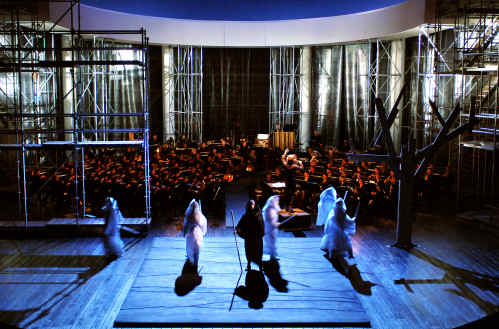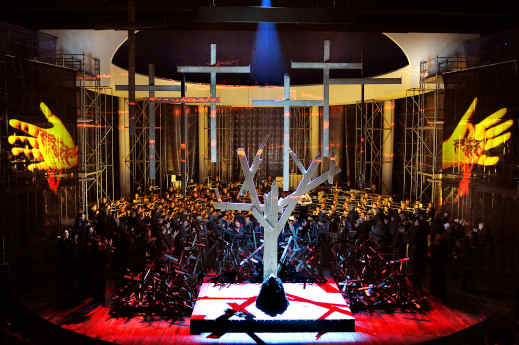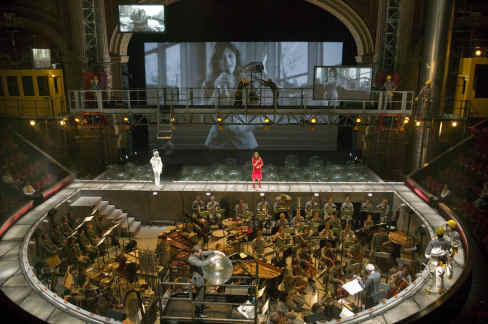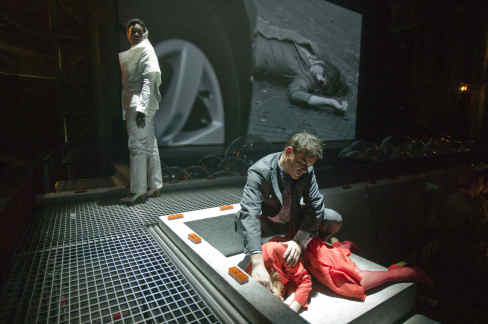Other Links
Editorial Board
- Editor - Bill Kenny
- Founder - Len Mullenger
Google Site Search
SEEN
AND HEARD INTERNATIONAL OPERA REVIEW
Holland Festival 2008, Messiaen and Andriessen : De Nederlandse Opera visits Heaven, Purgatory and Hell, Het Muziektheater and Koninklijk Theater Carré, Amsterdam, 18 /19.6.2008 (BK)
A constant directorial risk in this opera is to turn Messiaen's
heartfelt religious conviction into something baser; crude and
sentimental religiosity rather than genuine spiritual
expressiveness. But Audi and his team steer an unerring course
towards the core of Messiaen's intentions, treating the text with
discernible reverence while also sustaining the audience's interest.
The production works very well most of the time, with only one
small lapse
perhaps, in the long and difficult scene in which St.

Saint François d'Assise - Set
Messiaen's only opera Saint François d' Assise and La
Commedia,
The Innocent Ear - Part One: Heaven
Saint François is a truly epic work. Scored for a vast
orchestra requiring nine percussion players and three ondes
martenot, together with a chorus of 100 voices and
nine soloists, the opera runs for six hours including
intervals. The three act, eight scene plot shows François teaching his brother monks, healing a leper, encountering an angel and then
preaching to the birds: until finally, he acquires Christ's stigmata and
dies. The libretto, the composer's own, took almost
eight years to complete and is an extended meditation on the saint's
spiritual progress rather than a drama. Given this focus, a
certain degree of sympathy from the audience is
required for its success and there's a further problem
facing any director brave enough to tackle the work: what to do when so
very little happens but when celestial radiance - or the idea
of it - needs constant representation.
Pierre Audi's solution, with sets and lighting
by Jean Kalman and costumes by Angelo Figus is a simple yet
elegant tour de force. He puts the orchestra on
the stage
and surrounds it with sturdy scaffolding,
strong enough to support the entire chorus from time to time. The
plot plays itself out on
an apron over the unused pit
using only a minimum of props; a pile of wooden crosses and a
skeletal representation of monastic cells in the first act,
other larger rough hewn crosses in the second and third, some
symbolic trees and a
walkway running through the middle of the orchestra out to the back
of the stage. High above, the ceiling becomes the sky or a cathedral dome
by turns. These settings, the lighting plot and the costumes
are all immensely colourful, perfectly fitted to the composer's well
known synaesthesia and his personal love of the brighter hues.

Act III, Scene 7 - St. François receives the stigmata
The soloists are generally excellent with especially fine singing
from Rod Gilfry as François, Camilla Tilling as the Angel and
Tom Randle as Elie. The title role is a huge sing with the character
on stage almost all of the time, and needing to express emotions ranging from quiet dignity through to overwhelming
ecstasy on hearing the Angel's singing; and then ultimately to physical
and emotional identification with Christ's suffering. Gilfry
sustained all of this manfully, showing no sign of vocal fatigue at
any point even at the conclusion. Camilla Tilling too, as the
'angel unawares' in Act I, Scene 4 and then in
Scene 5 where she appears in full radiance to play celestial
music to François, sang with exceptional beauty of tone
while conveying both authority and perhaps the most difficult acting
requirement of all, rhapsodic virtue. Hers was a magnificent
performance by any standards.
In addition to the exceptional chorus, De Nederlandse Opera's own,
which fulfills a number of roles in the
plot including acting as the voice of Christ, much of the drama
missing from the stage representation is provided by the
orchestra: often by means of the score's leitmotiven for death, solemnity, grace and joy as
well as the imitation of birdsong, central to the composer's output
in general but particularly necessary in this opera. Under Ingo
Metzmacher's direction, the Residentie Orkest of The Hague,
augmented with a large battery of mallet instruments and the three
ondes played by Nathalie Forget, Valérie Hartmann-Clavérie
and Bruno Perrault, produced some truly
celestial, not to say cataclysmic sounds. To my innocent ear at
least - this was my first experience of this opera - there were no
noticeable lapses in ensemble or tuning and the entire performance
added up to one of the most memorable nights of opera that I have
heard in many years. The Victorian English writer, the Reverend
Sydney Smith, said that heaven would be 'Eating paté de foie
gras to the sound of trumpets.' Had he been able to hear this Saint
François, he might easily have changed his mind.
A concert performance of the production can be heard at the BBC
Proms on
Sunday 7th September at 4pm and will be broadcast by BBC Radio
3. Early booking would be both advisable and worthwhile.
The Innocent Ear - Part Two: Hell and Purgatory

The set for Louis Andriessen's La Commedia
Scaffolding
was clearly a feature of DNO's output this year, because more of
it was used for La
Commedia at the
Koninklijk
Theater Carré.
Louis Andriessen's 'Film Opera in Five Parts' is staged by the film
director Hal Hartley ('Flirt', 'The Book of Life', 'No Such
Thing' etc) whose latest collaboration with the composer -
there have been several others - is a work lasting almost two hours
without interruption. In essence, it's a condensation of Dante Alighieri's three volume Divine Comedy which describes the
poet's journey from Hell to Heaven accompanied first by the poet
Virgil and then by Beatrice.
It sounds confusing and it
is, although seeing a second performance would probably help. The staging
however is well done, with four screens showing the filmed action
while Dante, Beatrice, Lucifer and one of the Purgatory workers sing
from a walkway framing the orchestra. Behind the orchestra, the souls
in Purgatory and the river Styx are represented
by a trough of transparent plastic balls, some of which
the dungaree clad workers
hoist up to a gantry representing Paradise.
Except that it isn't - or not quite, anyhow. For his updating of
Dante's epic, Andriessen has tacked on settings of texts from
the Dutch poet Vondel, from the Old Testament and a Dutch folk song while
being influenced by other textual sources when writing the
music. The result is an uneasy confluence of two sets of stories,
one comprising Dante's original characters in modern guise and
another about a music ensemble called either 'The Guild' or 'The
Terrifying Orchestra of the 21st Century.' This idea is based simultaneously on
Dante's devils and a music group that Andriessen has sometimes
threatened to create to perform music that 'no normal orchestra
would play.' In La Commedia, The Guild plays on the streets of modern Amsterdam and
is often in
trouble with the police. Two 'social activist' girls called Maria
and Lucia also come to the city in the filmed story to hand out pamphlets during a visit by a
visiting dignitary (Beatrice, sung by soprano Ciaron McFadden), while Dante is seen as an Italian
television news journalist reporting the celebrity's visit.
He is confusingly shown as female (and sung by mezzo Cristina Zavalloni) while Lucifer (played and sung by the Dutch actor
Jeroen Willems) is meant to be 'an angry and resentful businessman
with frustrated political ambitions. '
Hal Hartley says in his programme notes that, 'For the evening', the
theatre is Purgatory,' where we find the combined ASKO/Schoenberg
Ensembles and Synergy Vocals conducted by Reinhold de Leeuw, while Purgatory's
workers
prepare souls for admission to Paradise. 'Like any
self-respecting corporate body,' he adds, 'Purgatory has.. video screens to keep an eye of Human Folly. Their current main
concern is with two days in Amsterdam.'
The plot runs like this. The Guild play their music on the streets,
collect their money and go to a bar called 'The Ship of Fools'
where Lucifer watches them. After Lucia is seduced by the groups'
horn player she is taken to the bar where everyone present gets
drunk and a fight breaks out. Next morning, Lucia and the band wake
up on a beach having been followed there by Maria. Arguments follow
and Lucia and Maria fight.
In the next episodes, the Guild goes to work once again but one member
gets into a fight with the police and they are all arrested. Lucifer
pays their fines and they are released while Maria watches. Lucifer
then outlines his plans to overthrow heaven to the band and later Beatrice
arrives at her hotel while Dante prepares for her on-camera
work. The Guild members boat down Amsterdam's canals trying to patch up their
differences. Beatrice appears on a balcony above the crowd waiting
for her in the street and Dante is so moved by her presence that
he/she accidentally steps into traffic and is killed by Beatrice's
limousine. The piece ends when the The Guild is chased from the
city, Beatrice leaves for the airport and Lucifer offers advice
about the state of things in Florence. A group of children sing that
even if we the audience don't know what's going on, then that's our problem because
they do, while the workers in Purgatory quietly send a soul upwards to
Paradise.

L-R Beatrice Lucifer and Dante
Andriessen's music is written for large orchestra and is
deliberately repetitive in the usual way of minimalism, but it
is very skilfully orchestrated and of sufficient melodic
interest to bear repeated hearing or even a recording. It is also often
very loud however, so much so that Synergy Vocals and the soloists
were all amplified. The orchestra and Synergy Vocals - all in dungarees too incidentally -
played and sang marvellously for
Reinhold de Leeuw while the best of the solo
singing came from Ciaron McFaddon - positively radiant when poised on
the high gantry at the beginning of the evening.
All in all then, a somewhat over-complicated piece of
music-theatre which could well be worth seeing twice to catch
up with the plot and sung texts. On the
other hand, Hal Hartley heads his programme notes with the title, 'My God, what
have we done?' Some people may think that's a particularly good question.
Bill Kenny
Pictures © Ruth Walz (St.François)
and Hans van den Bogaard (La Commedia)
Back to Top Cumulative Index Page
